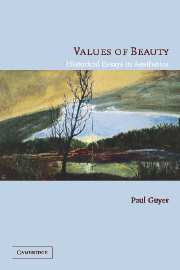Book contents
- Frontmatter
- Contents
- Introduction
- Acknowledgments
- Abbreviations Used in the Text
- I MOSTLY BEFORE KANT
- II MOSTLY KANT
- 3 The Harmony of the Faculties Revisited
- 4 Beauty and Utility in Eighteenth-Century Aesthetics
- 5 Free and Adherent Beauty
- 6 Kant on the Purity of the Ugly
- 7 Beauty, Freedom, and Morality
- 8 The Ethical Value of the Aesthetic
- 9 The Symbols of Freedom in Kant's Aesthetics
- 10 Exemplary Originality
- III MOSTLY AFTER KANT
- Bibliography of Works Cited
- Index
6 - Kant on the Purity of the Ugly
Published online by Cambridge University Press: 05 June 2012
- Frontmatter
- Contents
- Introduction
- Acknowledgments
- Abbreviations Used in the Text
- I MOSTLY BEFORE KANT
- II MOSTLY KANT
- 3 The Harmony of the Faculties Revisited
- 4 Beauty and Utility in Eighteenth-Century Aesthetics
- 5 Free and Adherent Beauty
- 6 Kant on the Purity of the Ugly
- 7 Beauty, Freedom, and Morality
- 8 The Ethical Value of the Aesthetic
- 9 The Symbols of Freedom in Kant's Aesthetics
- 10 Exemplary Originality
- III MOSTLY AFTER KANT
- Bibliography of Works Cited
- Index
Summary
Kant opens the “Analytic of the Beautiful” in the “Critique of the Aesthetic Power of Judgment” with the statement that “In order to decide whether or not something is beautiful, we do not relate the representation by means of understanding to the object for cognition, but rather relate it by means of the imagination (perhaps combined with the understanding) to the subject and its feeling of pleasure or displeasure” (CPJ, §1, 5:203). Kant then argues that only a pleasure in objects that is independent from their merely sensory agreeableness or their prudential or moral goodness is the ground for an affirmative judgment of their beauty, so it seems plausible to suppose that he also means to assert that there is a distinctive displeasure, free of any displeasure in an object's sensory disagreeableness or prudential or moral badness, on which a negative but still purely aesthetic judgment that such an object is ugly rather than beautiful must be based.
It might therefore seem that Kant's aesthetic theory must include an account of a purely aesthetic experience and judgment of ugliness as well as beauty.
- Type
- Chapter
- Information
- Values of BeautyHistorical Essays in Aesthetics, pp. 141 - 162Publisher: Cambridge University PressPrint publication year: 2005
- 8
- Cited by

